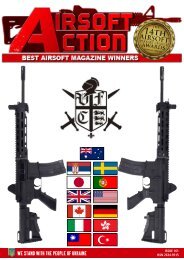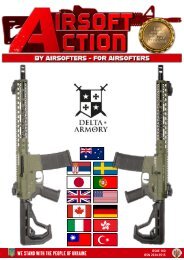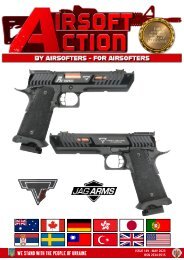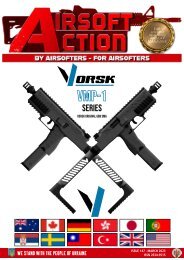PMCI - September 2021
It's been another hard slog for the PMCI crew this time, as curbs on international travel continue to curb our ability to actually get together but as usual, Bill and Trampas have pulled yet another great issue out of the (drag!) bag - and it's a very special one that headlines with a "Dream Rifle Build" that replicates the iconic Ruger Mini 14 as used by "Hannibal and the Team"... We do love it when a plan comes together! We're also joined again by Jim W, who brings a deep-dive insight into the world of profiling and we look in detail at what some of our favourite manufacturers have been up to, landing our test reports in full! All in all, it may have taken just a bit more time, and some serious "logistics juggling" to get this issue together but we hope you'll agree it's been worth the wait!
It's been another hard slog for the PMCI crew this time, as curbs on international travel continue to curb our ability to actually get together but as usual, Bill and Trampas have pulled yet another great issue out of the (drag!) bag - and it's a very special one that headlines with a "Dream Rifle Build" that replicates the iconic Ruger Mini 14 as used by "Hannibal and the Team"... We do love it when a plan comes together!
We're also joined again by Jim W, who brings a deep-dive insight into the world of profiling and we look in detail at what some of our favourite manufacturers have been up to, landing our test reports in full!
All in all, it may have taken just a bit more time, and some serious "logistics juggling" to get this issue together but we hope you'll agree it's been worth the wait!
- No tags were found...
You also want an ePaper? Increase the reach of your titles
YUMPU automatically turns print PDFs into web optimized ePapers that Google loves.
your purchase also includes a high-performance ASP 18650
rechargeable battery, battery storage case, retractable charging
cord, adjustable/removable pocket clip, and zippered ballistic
travel case.
SPECIFICATIONS:
Product Name: ASP RAPTOR DF (Dual Fuel)
Lumens: 1900 (high), 15, 300, Strobe (programmable secondary)
Run Time: 1.5 hours
Beam Distance: 240m
Power Source: High-performance ASP 18650 rechargeable battery
and accessories included, also can use CR123A battery (not
included)
Length: 6.5”
Diameter: 1.57”
Weight: 9.2 ounces (with batteries)
MSRP: US$197.00 USD
So, what is the Raptor DF and what does that DF mean? The Raptor
is the newest strategic-purpose light that ASP has put out into the
market. This product comes packing a punch with a whopping
1900 lumens of brilliant white LED output. If you are looking to
create some bright, artificial daylight, this is your tool. However,
as we know in this industry, we don’t always need the brightest
bulb in the room. With that in mind, ASP has you covered, as the
Raptor has the flexibility and adaptability to drop down into a
secondary programmable mode, in which the user can set it to a
15 or 300 lumen output, or strobe.
Now onto the DF, which stands for Dual Fuel. This means you
will never have to worry about being without a power source.
The Raptor will run with either a rechargeable 18650 battery
that is included or (2) CR123A primary single use cells, which
unfortunately are sold separately. However, the 18650 battery
charges inside the flashlight, using the supplied cord, or any
micro-USB phone/electronics charging cord, which means that
no separate battery charger is needed. Which in my opinion is a
game changer, as you can purchase some CR123A’s as a backup
while you charge the 18650 separately, and can still have use of
your light; or purchase a backup 18650, the choice is yours and
you will be able to stay in the fight without any downtime.
Additionally, there is an onboard indicator that displays the
recharging status and remaining power capacity of your Raptor.
The Raptor DF is machined from 6061 T6 aerospace aluminum,
type III hard coat anodized in a proprietary matte black finish. The
barrel is wrapped in ASP’s exclusive, all-weather foamed vinyl
grip. Premium components include Cree XHP-70 LED, gold-plated
connectors, polished aluminum reflector and optical glass lens.
Upon receiving the Raptor, I could not help but notice the
detail that was put into the packaging. The box was sturdy,
with pertinent information on it like the package contents and
especially the FL 1 performance standards (more on this in a
moment).
What is in the box besides our Raptor DF flashlight? Well,
Now before we get into the components, let’s touch on the
standards that were established in order to rate flashlight
performance. Back in 2009, an industry standard was put into
place by the American National Standards Institute (ANSI) for
rating flashlight performance. This standard has now become
commonly known as “FL 1” and it has been adopted by many
high-quality flashlight manufacturers. FL 1 provides definitions for
quantifying various aspects of a flashlight’s operation. Although
the specifications for drop-testing and water resistance are pretty
straightforward, the official definitions and testing methods for
lumen output and runtime are not easily understood by most
consumers.
Under the FL 1 standard, lumen output for any given flashlight
is measured starting 30 seconds after the activation of the
flashlight, since there can be significant dropoff before that point.
To report lumen output before that point, rather than waiting
for the light to “settle in” could be potentially misleading to
consumers.
Runtime, as defined by FL 1, is the amount of time elapsed
from the initial activation of the flashlight until the instant output
drops to 10% of the lumen rating in continuous operation. So,
with this definition, a 400-lumen flashlight producing a mere
41 lumens is still considered within its “runtime.” Though some
users may be dissatisfied with the that, the point is to have a
confident and honest gauge of how long you can expect to have light.
The most interesting and yet scary part of this standard that I
would like to share is that by understanding just these 2 definitions,
it becomes clear how easily an unscrupulous manufacturer might
mislead consumers; for example, by reporting lumen output
before the 30 second mark just to put a higher number on the box.
As for the runtime data, the FL1 standard only tests flashlights
in continuous operation until the batteries are depleted to the
point in which the output has dropped to 10% of rated output.
In reality, flashlights are seldom if at all used that way. From
a tactical operation perspective, flashlights are generally used in
momentary bursts or relatively short duration. But the standard
does provide the ability to compare flashlights objectively,
“apples to apples”
I know that I may have now raised some eyebrows regarding
flashlight standards, and rightfully so. When we purchase a
flashlight, it is for a serious purpose, and we expect it to perform.
So, after seeing how manufacturers might intentionally or
unintentionally provide incorrect data, our next question is, how
do we know we can trust what we see on a product?
I have some good news for you. In 2010, a group of executives
KIT: ASP RAPTOR DF
pmcimagazine.com


















